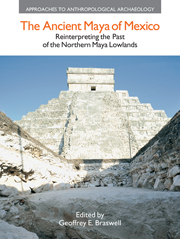Book contents
- Frontmatter
- Dedication
- Contents
- Contributors
- List of Figures
- List of Tables
- 1 The Ancient Maya of Mexico: Reinterpreting the Past of the Northern Maya Lowlands
- Part I THE PRECLASSIC PERIOD
- Part II THE EARLY AND LATE CLASSIC PERIODS
- Part III THE TERMINAL CLASSIC AND EARLY POSTCLASSIC PERIODS
- Part IV THE LATE POSTCLASSIC TO HISTORICAL PERIODS
- 11 Rain and Fertility Rituals in Postclassic Yucatan Featuring Chaak and Chak Chel
- 12 Poor Mayapan
- 13 Maya Collapse or Resilience? Lessons from the Spanish Conquest and the Caste War of Yucatan
- Part V CONCLUSIONS
- Index
13 - Maya Collapse or Resilience? Lessons from the Spanish Conquest and the Caste War of Yucatan
from Part IV - THE LATE POSTCLASSIC TO HISTORICAL PERIODS
- Frontmatter
- Dedication
- Contents
- Contributors
- List of Figures
- List of Tables
- 1 The Ancient Maya of Mexico: Reinterpreting the Past of the Northern Maya Lowlands
- Part I THE PRECLASSIC PERIOD
- Part II THE EARLY AND LATE CLASSIC PERIODS
- Part III THE TERMINAL CLASSIC AND EARLY POSTCLASSIC PERIODS
- Part IV THE LATE POSTCLASSIC TO HISTORICAL PERIODS
- 11 Rain and Fertility Rituals in Postclassic Yucatan Featuring Chaak and Chak Chel
- 12 Poor Mayapan
- 13 Maya Collapse or Resilience? Lessons from the Spanish Conquest and the Caste War of Yucatan
- Part V CONCLUSIONS
- Index
Summary
Abstract
Recent calls to extricate the Maya from the stereotype of collapse have singled out cultural resilience as the viable new brand for the political present. In this paper I examine two episodes of Maya collapse and reorganization in Yucatan: the Spanish invasion (A.D. 1511–1546) and the Caste War (A.D. 1847–1901). Using the framework of resilience theory, I explore archaeological evidence of settlement aggregation and dispersal, reorganization of the built environment, and household production to reveal how strategies enacted before each catastrophe compare with those of their aftermaths. My evidence suggests that some native communities pursued consistent strategies that maintained or increased resilience of historic-period socioecological systems, whereas others suffered losses of autonomy under the Spanish colonial and post-independence regimes.
Will Andrews' approach to the Classic Maya collapse always has been to assemble empirical archaeological evidence to explain variations in social transformations (Andrews et al. 2003; Sabloff and Andrews 1986; see also Andrews 1990). Viewing the Classic-period collapse of the central and southern lowlands as the apocalyptic endgame of a great tradition just does not work well for archaeologists who work in Yucatan. The consensus reached by contributors to a recent volume on the Terminal Classic in the Maya Lowlands is that Andrews is right (Demarest et al. 2004).
- Type
- Chapter
- Information
- The Ancient Maya of MexicoReinterpreting the Past of the Northern Maya Lowlands, pp. 325 - 346Publisher: Acumen PublishingPrint publication year: 2012

